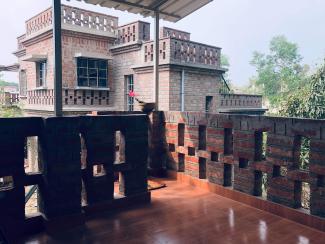
Studio Goppo
Studio Goppo, an artist-run residency programme and a research studio for Alternative analogue photography. A studio that is dedicated to exploring, collecting, rebuilt the history of photography from a contemporary perspective. The residency encourages experiments with the 19th-century photographic processes. The studio provides support to the artist with the knowledge of hands-on skills and critical discourse.
Artist talk and exhibitions: The resident artist must share the project at the end of the program by putting an exhibition in studio Goppo. The artist should also deliver at list one Artist's talk presentation at studio Goppo during the residency program.
It is a common studio which the resident artist will share with other artists. There is a 140sqft darkroom available, homemade silver-gelatin dry plate, homemade silver gelatin emulsion paper, gum print, cyanotype, kallitype, dusting on the process, calotype, develop out salted paper, wet plate collodion, dry plate collodion and so on. Other than the darkroom the studio has around the 400sqft working area with all other necessary amenities. There is a storage unit for paper, negatives, chemicals, equipment in this space. The studio is surrounded by a vast green plantation and open space around.
The residency accommodation space is an air-conditioned room with attached private bathroom and a pantry with an open balcony. The room is for one person. The space has a wifi connection with electric cooking equipment (A microwave, rice cooker, toaster, food processor, etc.) and a refrigerator. It has a dedicated space for the kitchen garden and resident artists are encouraged to participate in gardening. The space is located on the first floor of the studio itself. A bicycle will be provided for daily convince. There are supermarkets in the nearby town.
Equipment: Eleven age-old wooden plate cameras of various sizes, enlargers, UV printing unit, laboratory equipment, desecrater, magnetic stirrer cum heater, etc. Basic wood and metalworking tools, Basic printmaking tools screen-printing setup, etc. A library dedicated to the historical photographic process, photography history and critical writing on photography. The resident artist can use all of these.
Available expertise: A dedicated workshop/ tutorials on-demand or expertise related theoretical and practical issues and an assistant to realize the project is available on payment during the residency program.
Workshop: Paid workshops for the resident artist if they need. Workshops or tutorials can be taken on the following process: monochrome and 3 color gum-print, calotype, kallitype, wet plate collodion, dry plate collodion, dust on process, cyanotype, camera making, developed out salt paper, Albumen print, homemade silver-gelatin dry plate, homemade silver gelatin emulsion paper.
Library: A collection of books on alternative photography, published in the 19th century to present days are available for references.
Theoretical support: If required the artist could also get a theoretical interaction with art historians to support his/her project.
The place Santiniketan is known as a university town. ‘Visva Bharati’, the University founded by the great Indian poet and noble laureate Rabindranath Tagore. The fine arts department of this institution is a 100 years old, which is regarded as the first modern school of art in India which has contributed significantly in the modern Indian art practice. Being an important institution of the country, there is a constant flow of people from various part of the world.
Other than the institution this place has a large number of artists. Private studios and other residency programs, dedicated to various activities such as ceramics, visual art, printmaking, traditional craft, studio for textile designing, theatre and performing arts, center for folk music, organic farming and so on.
The resident artist is expected to visit these spaces to explore and interact. This communication with other local organizations, artists and intellectuals could lead and contribute for further development to build a network.





